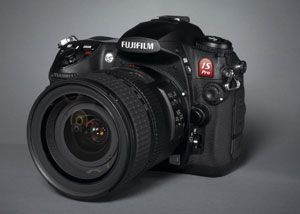I recently tested the FujiFilm FinePix IS Pro DSLR (Digital Single Lens Reflex) camera. My tests concluded that the IS Pro meets the needs of law enforcement agencies worldwide.
The FujiFilm Finepix IS Pro is a 12.3 megapixel digital SLR specifically designed for professional photography of images that go beyond the visual spectrum of the human eye. It was designed to be used with a selection of filters from PECA for limiting the spectrum of certain wavelengths to the image. It is based on the FujiFilm Finepix S5 Pro DSLR body, which allows it to mount the entire library of Nikon F lenses and iTTL flash systems, one of the largest selections in professional photography. The IS Pro uses Fujifilm’s Super CCD Pro, a CCD designed to more accurately capture an image than conventional DSLRs.
 The FujiFilm Finepix IS Pro is a 12.3 megapixel digital SLR specifically designed for professional photography of images that go beyond the visual spectrum of the human eye. The FujiFilm Finepix IS Pro specifically addresses some of the concerns of evidence collectors and is a reflection of FujiFilm’s commitment to the law enforcement industry. It has all of the features that place it on the pinnacle of forensic cameras, and then some. |
The IS Pro has a rugged alloy chassis and tactile controls with simple icons and detent clicks. It is heavier and larger than similar products but is easily steered and manipulated in the hands. All of the peripheral openings are sealed against the elements and it is obvious that the IS Pro was set up for prolonged use. FujiFilm wisely included an LCD protective cover that did not get in the way of daylight or low light shooting, a focus illuminator, which is separate from the pop up flash and USB, video and remote connectors.
Before FujiFilm began marketing digital forensic cameras, several companies were modifying existing digital cameras to shoot at extended range. These modifications are expensive and often rendered the products useful for only a limited spectrum. FujiFilm recognized the need for an advanced product and added the features to the product line already known for durability and reliability.
My IS Pro came supplied with a set of UV/IR filters made by PECA Products especially for this camera.
The human eye can only see a range of about 400-700nm. All other light is considered invisible to the eye. On one end of the spectrum is Ultraviolet (UV), which is about 10-400 nm, and infrared(IR), about 750nm-1mm. Being able to “see” these wavelengths is handy for medical, forensic and manufacturing applications because things are often revealed that would otherwise go unnoticed.
A UV/IR camera is useful for distinguishing gunshot residue, body fluids and bones, bruises, tattoos and injuries already healed and examining documents for alterations. With extended spectrum, one can distinguish anomalies in patterns like identifying a patch of marijuana in a landscape or a blood stain on a dark carpet.
The FujiFilm Finepix IS Pro addresses some of the concerns of evidence collectors. For example, many DSLR cameras produce images in RAW format. This format is great for portrait photography because RAW images contain more information than conventional digital images. Unfortunately, RAW images always need some sort of processing, using software, in order to make them usable. In other words, they cannot be used as a simple photograph once downloaded from the camera. This is problematic in the evidence world as “rendered” images may inject the question of authenticity and therefore admissibility. The FujiFilm Finepix IS Pro is capable of delivering unprocessed tiff images, the same way consumer cameras will.
For an alternative wavelength camera, it has tremendous sensitivity (up to 3200 ISO) and low noise image quality. I was able to shoot at this ISO and expand the image to huge proportions without image defects. The sensitivity of the CCD was most evident when shooting in almost total darkness with an IR illuminator. The IS Pro is a powerful tool for surveillance because of the difference in clarity between an IR video camera and a high end still camera.
Even with the advent of digital cameras, few products had this flexibility. With the IS Pro, the photographer can tripod the camera, shoot the visible light shot, change filters and shoot the non visible light shot using the same exact perspective, focus and camera. This is much easier to put before a jury.
I found the professional features like the “mirror up” shooting mode allowed photographic quality that crime scene capturers usually do not have. When the shutter is clicked on an SLR, the mirror which raises the image into the viewfinder ( so the photographer can see what he is capturing) has to flip up in order to put the image on the CCD. Although an SLR mirror is rather light, it is enough to cause a vibration shudder in the camera, even on a heavy tripod. This is not a big deal if the shutter speed is a 125th of a second. It is a really big deal if the shutter speed is 2-30 seconds. When shooting with UV or IR, the vibration is enough to completely blur an image. The mirror up feature was easy to use and it could be set to stay up for a maximum of 30 seconds or delay the shutter to allow the camera to settle.
I know that this camera was designed for photography professionals and I do not wish to make light of the intensive training and experience that a technician has. However, this camera is useful for the low budget operation also. This is because FujiFilm has pioneered the Live Image CCD Preview on an evidence camera. In this mode, the mirror is flipped up for 30 seconds and the image that is captured on the CCD plays on the LCD. What the camera sees, you see.
Using the Live Image CCD Preview, I wrote on a card in blue ballpoint, and then scribbled over it with two permanent markers. I used several different PECA IR filters (and some strategic illumination), looking through the LCD to see my results. I could focus and adjust my tripod in order to prepare for the capture. This is a big plus as most forensic filters are opaque to the eye and once on the camera, focusing is done by estimation. It took me only five tries to isolate two of the inks, using simple light sources. Anyone at any level of expertise can recognize that FujuFilm has made science fiction a reality.
Evidence photographers find themselves shooting at varied angles and situations. The technology for tilting the LCD is there and this would complete the IS Pro package. In its defense, however, I found I could read the LCD at oblique angles better than similar products, even with the supplied LCD cover on.
The FujiFilm Finepix IS Pro can prevent problems experienced with focus shift. Focus shift is a phenomenon where light spectrum components pass through the elements of the lens at different speeds. These components are separated by the different types of glass, much like a prism. This causes the different opponents to focus differently than visual light. A person looking through the viewfinder of an SLR camera will focus using the light they can see. This is fine if the photograph is composed of visible light. If they use light that they can see to focus an ultraviolet shot, the point of focus (where light converges on the film plane and therefore is sharp) will not necessarily be on the film plane. This will cause anything focused using the eye to be out of focus using UV exposure. The FujiFilm Finepix IS Pro enables the user to preview what is on the film plane right on the LCD. In other words, what the camera is seeing, the photographer sees. UV photographs will be in focus.
Before this technology was available, forensic photographers would show up to a crime scene with several rolls of film and shoot a lot of exposures. They would bracket the focus, meaning they would shoot a range of photographs of the same subject over different focal planes, or use the IR focusing marks supplied on some cameras. There are other limitations to film cameras in the forensic world. For example some 35mm cameras have light sources where the film travels that wont expose portrait film but will expose IR film.
The FujiFilm FinePix IS Pro takes XD, CF and Microdrives, and I appreciate the option. For the crime scene investigator, it also allows for tethered shooting, meaning it can be linked to a laptop, where the images are stored when captured. If large scale processing like a disaster scene or major incident is necessary, there are optionally purchased enhancements that can facilitate this. For example, this camera can be coupled with equipment that will link information with bar code and LAT/LON tags, using a bar code reader and a GPS device. This kind of equipment would serve a MAIT (Multidisciplinary Accident Investigation Team) unit or other specialized unit that must quickly process and analyze a lot of information.
Every camera treats its portable memory differently. I clocked how quickly the IS Pro writes on my 2gb CF card by shooting the same size and resolution photo in an older camera and the IS Pro. In my own camera collection, the IS Pro varied from twice as fast to slightly faster in the time it took from clicking the shutter to writing to the CF card. It was perfectly capable of high resolution bursts and outran several cameras in my own collection. It also accessed the stored photos like a champ. During rapid fire sequences, it was able to buffer high resolution pictures to allow the camera to keep on shooting while writing to the card. I also appreciated the recessed design of the connections for CF cards, which prevents misalignment of the pins. This is the bete noire CF card digital cameras and FujiFilm has addressed it nicely.
The IS Pro has one of the most useful focusing screens in the industry. This is not limited to one model; FujiFilm simply makes brighter viewfinders with easily interpreted information in them. The IS Pro superimposes the exposure settings on the bottom edge and has semitransparent framing and metering references midscreen. These references change when one changes the shooting mode, providing a semitransparent “heads up” display that can be switched using the thumbwheel and fingerwheel controls in the ergonomic grip.
FujiFilm claims about 320 frames per charge, using the supplied battery when the low temp polysilicon TFT monitor is off. I consistently got about 5 percent more usage, even when reviewing my shots between frames and often using the Live Image View feature. I did not test the GPS or barcode features. The flash, like most DSLR flashes, is mostly useful for fill but it was simple to operate without losing track of the subject.
The FujiFilm FinePix IS Pro is a reflection of FujiFilm’s commitment to the law enforcement industry. It has all of the features that place it on the pinnacle of forensic cameras, and then some.


